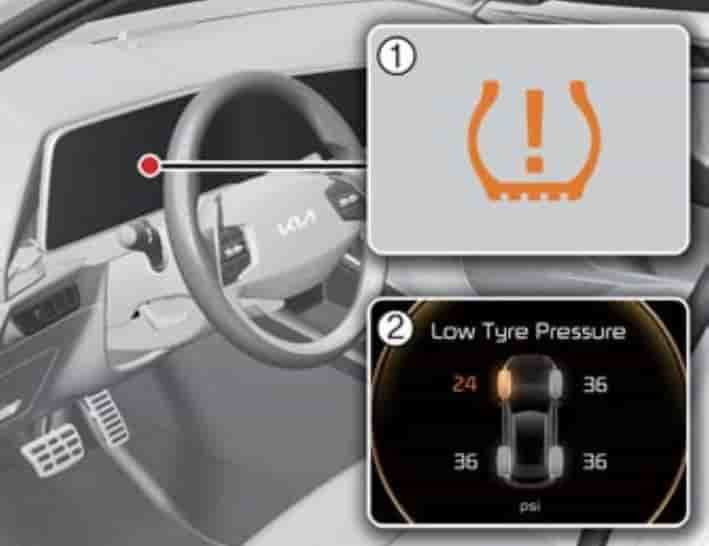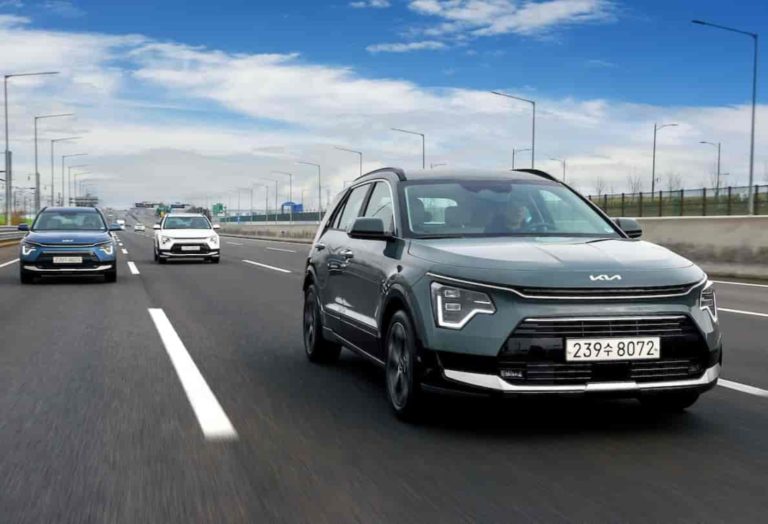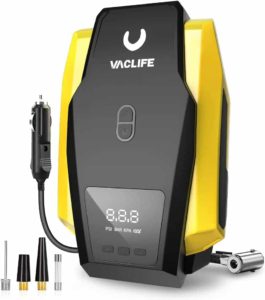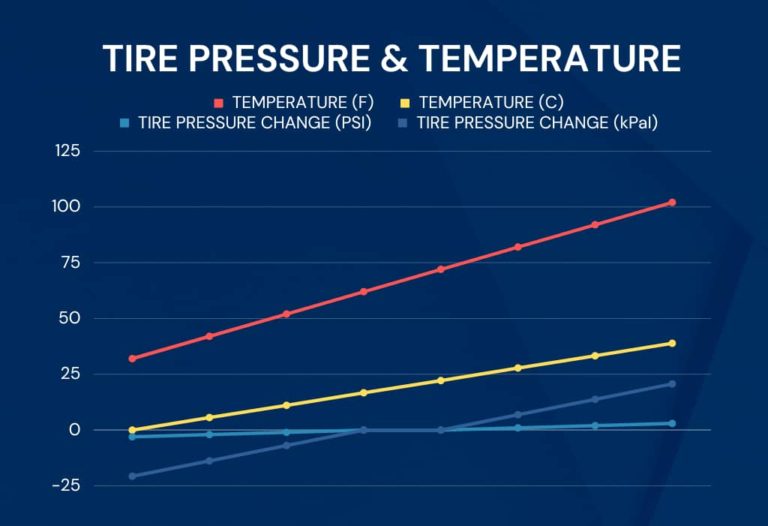The Kia Niro doesn’t come with a button to reset the tire pressure. But don’t stress! If you follow the steps in this guide, you’ll be able to switch off your tire pressure light without any issues.
What is the Kia Niro Tire Pressure Monitoring System?
We know that seeing that yellow exclamation point glowing on your dashboard is annoying, but it has an important purpose!
The tire pressure monitoring system (TPMS) in the Kia Niro is a built-in safety feature designed to keep the driver informed about the pressure in the vehicle’s tires. This system plays a pivotal role in maintaining optimal tire pressure, thereby enhancing the overall driving experience. By providing real-time updates and alerts, it enables the driver to ensure the vehicle’s tires are always in good condition, which contributes to improved vehicle safety, performance, and tire longevity. To check your tire pressure: check your tire pressure by pressing the mode button on your steering wheel and scroll over to the information mode to see your current pressures. Or use an accurate tire pressure gauge.
2024 Kia Niro Tire Pressures
Tire Size | FRONT PSI | REAR PSI |
205/60R16 | 36 | 36 |
225/45R18 | 36 | 36 |
SPARE TIRE | 60 | 60 |
Steps to Reset the Kia Niro Low Tire Pressure Light
The Kia Niro does not have a tire pressure reset button.
When the tire pressure light on the dashboard lights up, pull over and check your tire pressure right away.
Determine which tire is causing the tire pressure light to turn on and adjust the tire pressure accordingly.
Fill your tire to the exact recommended pressures. (36 Psi) I cannot emphasize this enough, accuracy is key. Your tire pressure will display after a minute or two of driving.
Drive your Kia Niro. Drive for a few minutes at speeds over 20 Mph.
If the light doesn’t go off right away, re-check your tire pressure to make sure they are all at the exact pressure you set them to. If they are down in pressure, you probably have some sort of tire leak.
If the pressures are at the exact pressure you set them to and the tire light still won’t go off, over fill your tires.
We recommend filling your problem tire with 45 Psi or about 10 Psi over the recommended pressure. With the tire overfilled, drive the car again for 10 or 15 minutes. This will turn off the tire light.
Now that the tire light is off, readjust the pressure back to 36 Psi.
How Does the Kia Niro TPMS Work?
Sensor Placement: The TPMS of a Kia Niro uses tire pressure sensors located inside each tire, except for the spare. These sensors are attached at the end of each tire valve on the inside of the tire.
Sensor Functionality: Each sensor measures the air pressure inside the tire. They are battery-powered and can last several years, but they will eventually need to be replaced when the battery dies. The batteries cannot be replaced.
Pressure Reading: The sensors continuously monitor the tire pressure while the vehicle is in motion. The system also monitors tire temperature, which can affect the pressure readings.
Transmission of Data: Each sensor transmits the tire pressure data wirelessly via radio frequency to the TPMS control module (also known as the receiver), located inside the vehicle. This data transmission occurs at regular intervals or if a significant pressure change is detected.
Pressure Standards: The TPMS control module compares the current received pressure readings with the pre-set optimal tire pressure levels, 36 Psi. (specified on the Kia Niro sticker located on the driver’s side door jamb).
Warning Activation: If the tire pressure in any of the tires falls below or exceeds the specified range, the control module sends a signal to the vehicle’s onboard computer system. The system usually uses 10 or 15% as its threshold. For example, 15% of 36 Psi is 5.4 Psi. This means when the tires are at 31 Psi (36 – 5), the Kia Niro will activate the warning light on your LCD.
Driver Notification: Upon receiving the signal from the control module, the onboard computer activates a warning light on the dashboard, alerting the driver that the tire pressure is not optimal. The Niro will also specify which tires are low on pressure.
Resetting the System: After the tire pressure has been corrected, the TPMS needs to be reset. Follow the 8 steps above to reset your tire pressure system.
System Self-Check: The TPMS performs a self-check each time the vehicle is started. If there is an issue, such as a sensor failure, the TPMS warning light will blink for about a minute before staying on. This alerts the driver that the system itself needs servicing. Read below to learn more about TPMS malfunctions.
What is the Kia Niro TPMS Malfunction Indicator?
Your Kia Niro also has a special warning light to alert you to potential issues with your tire pressure monitoring system (TPMS). It’s called the TPMS malfunction indicator. This warning light displays a yellow exclamation point, identical to the standard tire warning light. If there is a problem with the TPMS, the light will flash for about 60 seconds before staying on. This sequence will occur every time you start your car until the issue is resolved. So, when your tire light is flashing or blinking, the system may not be able to accurately detect low tire pressure. Basically, a blinking tire pressure light typically signals a malfunction within the TPMS itself, rather than an actual tire pressure issue. Often, this is due to a defective pressure sensor in one of your tires. To determine which sensor is faulty, use a TPMS diagnostic tool.
What Sets Off the Low Tire Pressure Light?
Seasonal temperature changes: A drop in ambient temperature can cause tire pressure to decrease, triggering the warning light.
Tire puncture or leak: A sharp object or road debris like a nail or screw may puncture a tire, causing air loss which will of course activate the warning light.
Faulty tire pressure sensor: Damaged or malfunctioning sensors may provide inaccurate readings, resulting in a false alert. The only way to determine which sensor is faulty is to scan each sensor with a TPMS diagnostic tool.
Valve stem issues: A damaged or leaking valve stem can lead to gradual pressure loss and eventual activation of the tire pressure light. They make kits to replace the rubber gasket that usually goes bad.
Tire damage: Impact from potholes or hitting a curb can cause structural damage like tire bubbles, leading to pressure loss.
Sensor battery life: TPMS sensors are battery-powered, and over time, batteries die. (they usually last anywhere from 5-10 years) This will cause the tire pressure light to turn on. Again, you must use a diagnostic tool to determine which sensor is dead or dying.
Recent tire rotation or replacement: If the tires have been recently rotated or replaced, the TPMS may need recalibration to avoid false alerts. Sometimes the vehicle’s computer may think the front tires are in the rear and rear in the front after a rotation.
Wheel or rim issues: Damaged, corroded, or cracked wheels or rims can lead to air leaks and pressure loss. This is very common with low profile tires.
Altitude changes: Climbing or descending in elevation can affect tire pressure and trigger the TPMS warning.
Natural pressure loss: Tires lose air pressure over time due to temperature changes and permeation. Tire dry-rot will happen to tires that sit.
Electrical problems or software issues within the car’s TPMS system. Occasionally the system may have a software update.
What Happens When Tires are Underinflated or Overinflated?
When tires are underinflated, that means they don’t have enough air pressure for optimal performance. Here’s what happens:
Decreased Fuel or Range Efficiency: Underinflated tires don’t roll as efficiently as they should. They create more resistance on the road, meaning your Kia Niro has to work harder to move, which results in higher fuel or range consumption.
Increased Tire Wear: Because underinflated tires have more surface area in contact with the road, they wear out quicker. The tread wear tends to be uneven, too, with the edges of the tire wearing out faster than the middle.
Reduced Handling: Underinflation can also affect your Niro’s handling, making it harder to steer, especially at higher speeds. This can lead to potentially dangerous situations, especially in emergency maneuvers.
Overheating Risk: Underinflated tires can get extremely hot and overheat due to excessive friction, which can lead to tire failure or even a blowout, especially during high-speed driving or on hot days.
On the other hand, when tires are overinflated, they have too much air pressure. Here’s what that does:
Reduced Traction: Overinflated tires have less contact with the road, which decreases traction. This can make your Kia Niro more difficult to handle, especially when roads are wet or during sudden stops.
Increased Wear in the Center: Unlike underinflated tires, overinflated tire treads wear more in the center of the tread, which can lead to premature replacement.
Increased Risk of Damage: Overinflated tires are less able to absorb shocks from potholes or road debris. This can lead to damage to the tire, the rim or wheel, and sometimes even the suspension.
Harsher Ride: More air means less flexibility for the tire to adjust to road imperfections, so you may find the ride less comfortable with overinflated tires. You will feel every bump in the road.
In both cases, the Tire Pressure Monitoring System (TPMS) on your Kia Niro will alert you if the tire pressure is not within the recommended range, allowing you to adjust the pressure and avoid these problems.
How Does the Weather Affect Tire Pressure?
Weather plays a surprisingly significant role in your tire pressure. The principle is rooted in basic physics: air contracts when it’s cold and expands when it’s warm. This means on a chilly morning the air inside your tires contracts, causing your tire pressure to drop. In fact, for every 10-degree Fahrenheit drop in temperature, your tire pressure can decrease about 1-2 PSI (pounds per square inch). On the flip side as temperatures rise the air inside your tires expands, which leads to increased tire pressure. This is why it’s important to check your tire pressure regularly, especially when there are significant temperature fluctuations!
How to Adjust Tire Pressure?
Get a high-quality tire gauge.
Make sure to check the tire pressure when the tires are cold. “Cold” means your vehicle has been idle for at least three hours or driven less than 1 mile.
Take off the valve cap from the tire valve stem.
Push the tire gauge firmly onto the valve to measure the pressure.
Compare the pressure reading with the recommended pressure on the tire information label. 36 Psi.
If the pressure is lower than 36 Psi, add air.
If the pressure is too high, let out some air by pressing the metal stem in the center of the tire valve. You can use any object like a screwdriver to do this. Be gentle.
Recheck the tire pressure with the gauge.
Don’t forget to put the valve caps back on to prevent leaks and keep dirt and moisture out.
When Should You Adjust Your Tire Pressure?
The best time to check and adjust the air in your Kia Niro’s tires is in the morning or after your car has been sitting for a while. This is because your tires need to be cool for an accurate reading. Driving warms up your tires and the air inside them, which makes it seem like there’s more pressure than there actually is. So, don’t mess with your tire pressure after driving – it won’t give you an accurate reading and could cause problems! For the most accurate check, make sure your car hasn’t been driven for a few hours.
What are the Benefits of the TPMS?
Think of the tire pressure monitoring system (TPMS) in your Kia Niro like a helpful friend who’s always looking out for you. It constantly keeps an eye on the air pressure in your tires. If the air gets too low, it lets you know right away, helping you avoid a flat tire or even a dangerous situation on the road. But it doesn’t stop there. By helping you keep the right amount of air in your tires, the TPMS also makes sure your car gets the best mileage possible and helps your tires last longer. (we know this is especially important with EV’s) So, it’s not just about safety—it’s also about saving you money and giving you a smooth, comfy ride. Thus, the TPMS serves as a valuable tool in preserving both your vehicle’s health and your peace of mind on the road.
Conclusion
In conclusion, the tire pressure Monitoring System in your Kia Niro is a powerful tool designed to optimize your driving experience and ensure your safety. It enhances your vehicle’s fuel efficiency or range and prolongs tire life and even helps you avoid dangerous situations on the road. By understanding the impacts of weather changes, knowing when and how to adjust your tire pressure, and effectively utilizing your vehicle’s TPMS, you can enjoy a smoother ride, save money, and gain peace of mind. It’s all about making informed decisions and taking proactive steps to maintain your vehicle’s health. So, keep an eye on that tire pressure light – it’s your car’s way of looking out for you! Everything in this article is applicable to all Kia Niro models and trims 2016 – 2024 including the Kia Niro Hybrid, Niro EV, and Niro Plug-in Hybrid.





